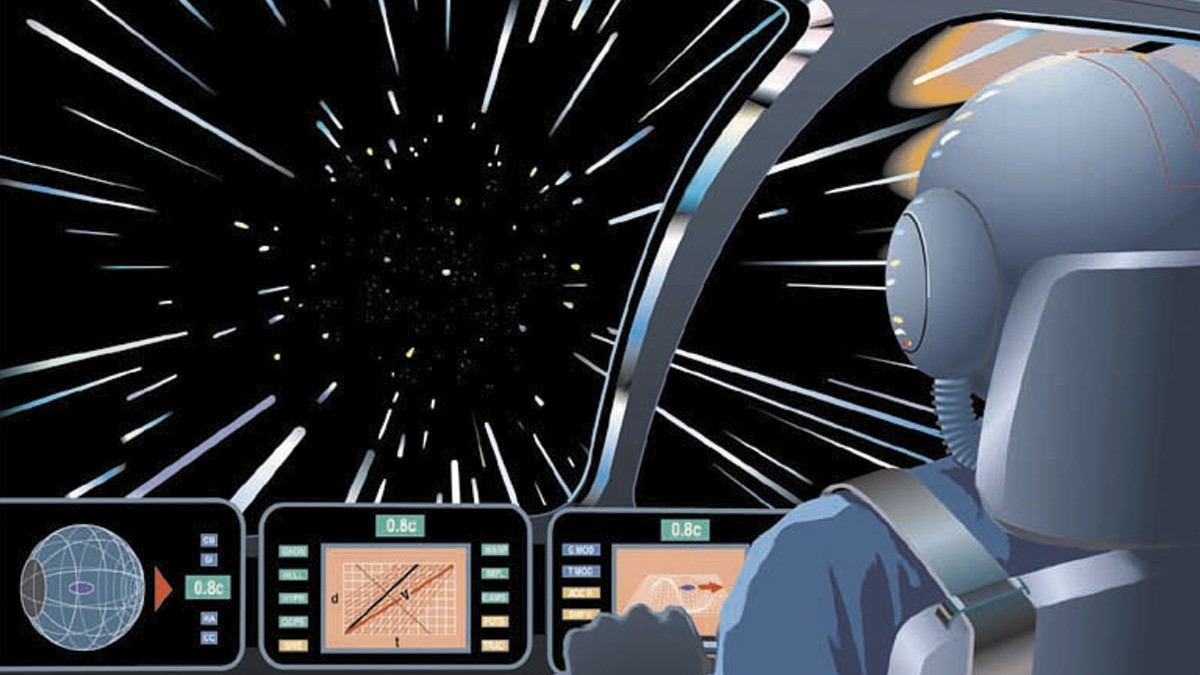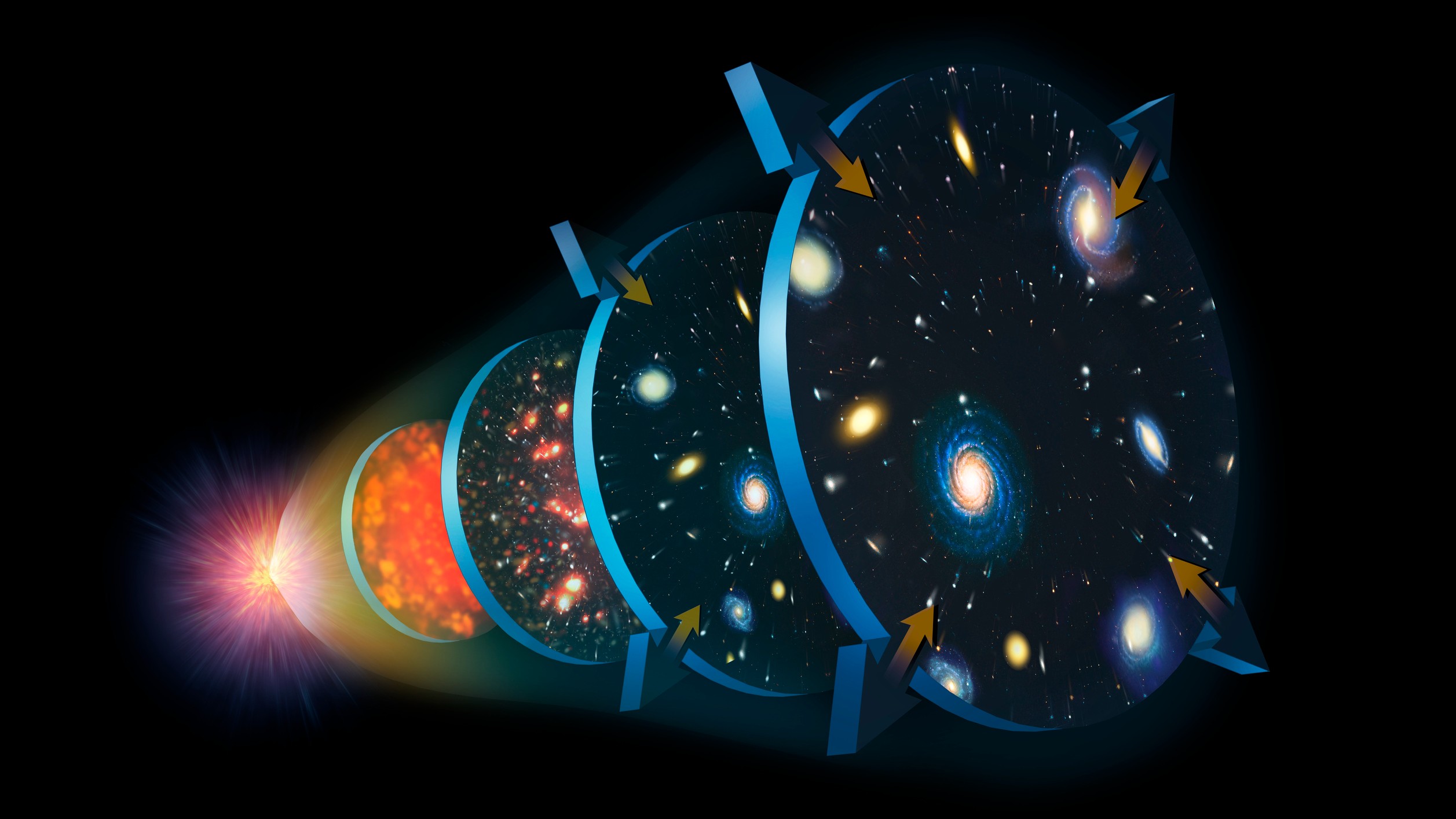7 ways Einstein changed the world
There are many ways Einstein changed the world, and his ideas have shaped the way we see and interact with the universe.

We take a look at seven ways Einstein changed the world. Albert Einstein (1879-1955) is one of the most famous scientists of all time, and his name has become almost synonymous with the word "genius." There are many ways Einstein changed the world, we explore some of our favorites here. While his reputation owes something to his eccentric appearance and occasional pronouncements on philosophy, world politics and other non-scientific topics, his real claim to fame comes from his contributions to modern physics, which have changed our entire perception of the universe and helped shape the world we live in today.
Here's a look at some of the world-changing concepts we owe to Einstein
Related: Why some physicists really think there's a 'mirror universe' hiding in space-time
1. Space-time

One of Einstein's earliest achievements, at the age of 26, was his theory of special relativity — so-called because it deals with relative motion in the special case where gravitational forces are neglected. This may sound innocuous, but it was one of the greatest scientific revolutions in history, completely changing the way physicists think about space and time. In effect, Einstein merged these into a single space-time continuum. One reason we think of space and time as being completely separate is because we measure them in different units, such as miles and seconds, respectively. But Einstein showed how they are actually interchangeable, linked to each other through the speed of light — approximately 186,000 miles per second (300,000 kilometers per second).
Perhaps the most famous consequence of special relativity is that nothing can travel faster than light. But it also means that things start to behave very oddly as the speed of light is approached. If you could see a spaceship that was traveling at 80% the speed of light, it would look 40% shorter than when it appeared at rest. And if you could see inside, everything would appear to move in slow motion, with a clock taking 100 seconds to tick through a minute, according to Georgia State University's HyperPhysics website. This means the spaceship's crew would actually age more slowly the faster they are traveling.
2. Einstein's equation: E = mc^2

An unexpected offshoot of special relativity was Einstein's celebrated equation E = mc^2, which is likely the only mathematical formula to have reached the status of a cultural icon. The equation expresses the equivalence of mass (m) and energy (E), two physical parameters previously believed to be completely separate. In traditional physics, mass measures the amount of matter contained in an object, whereas energy is a property the object has by virtue of its motion and the forces acting on it. Additionally, energy can exist in the complete absence of matter, for example in light or radio waves. However, Einstein's equation says that mass and energy are essentially the same thing, as long as you multiply the mass by c^2 — the square of the speed of light, which is a very big number — to ensure it ends up in the same units as energy.
This means that an object gains mass as it moves faster, simply because it's gaining energy. It also means that even an inert, stationary object has a huge amount of energy locked up inside it. Besides being a mind-blowing idea, the concept has practical applications in the world of high-energy particle physics. According to the European Council for Nuclear Research (CERN), if sufficiently energetic particles are smashed together, the energy of the collision can create new matter in the form of additional particles.
3. Lasers

Lasers are an essential component of modern technology and are used in everything from barcode readers and laser pointers to holograms and fiber-optic communication. Although lasers are not commonly associated with Einstein, it was ultimately his work that made them possible. The word laser, coined in 1959, stands for "light amplification by stimulated emission of radiation" — and stimulated emission is a concept Einstein developed more than 40 years earlier, according to the American Physical Society. In 1917, Einstein wrote a paper on the quantum theory of radiation that described, among other things, how a photon of light passing through a substance could stimulate the emission of further photons.
Einstein realized that the new photons travel in the same direction, and with the same frequency and phase, as the original photon. This results in a cascade effect as more and more virtually identical photons are produced. As a theoretician, Einstein didn't take the idea any further, while other scientists were slow to recognize the enormous practical potential of stimulated emission. But the world got there in the end, and people are still finding new applications for lasers today, from anti-drone weapons to super-fast computers.
Related: The world's biggest laser: Function, fusion power and solving a supernova
4. Black holes and wormholes

Einstein's theory of special relativity showed that space-time can do some pretty weird things even in the absence of gravitational fields. But that's only the tip of the iceberg, as Einstein discovered when he finally succeeded in adding gravity into the mix, in his theory of general relativity. He found that massive objects like planets and stars actually distort the fabric of space-time, and it's this distortion that produces the effects we perceive as gravity.
Einstein explained general relativity through a complex set of equations, which have an enormous range of applications. Perhaps the most famous solution to Einstein's equations came from Karl Schwarzschild's solution in 1916 — a black hole. Even weirder is a solution that Einstein himself developed in 1935 in collaboration with Nathan Rosen, describing the possibility of shortcuts from one point in space-time to another. Originally dubbed Einstein-Rosen bridges, these are now known to all fans of science fiction by the more familiar name of wormholes.
5. The expanding universe

One of the first things Einstein did with his equations of general relativity, back in 1915, was to apply them to the universe as a whole. But the answer that came out looked wrong to him. It implied that the fabric of space itself was in a state of continuous expansion, pulling galaxies along with it so the distances between them were constantly growing. Common sense told Einstein that this couldn't be true, so he added something called the cosmological constant to his equations to produce a well-behaved, static universe.
But in 1929, Edwin Hubble's observations of other galaxies showed that the universe really is expanding, apparently in just the way that Einstein's original equations predicted. It looked like the end of the line for the cosmological constant, which Einstein later described as his biggest blunder. That wasn't the end of the story, however. Based on more refined measurements of the expansion of the universe, we now know that it's speeding up, rather than slowing down as it ought to in the absence of a cosmological constant. So it looks as though Einstein's "blunder" wasn't such an error after all.
6. The atomic bomb

Einstein is occasionally credited with the "invention" of nuclear weapons through his equation E = mc^2, but according to the Max Planck Institute for Gravitational Physics's Einstein Online website, the link between the two is tenuous at best. The key ingredient is the physics of nuclear fission, which Einstein had no direct involvement with. Even so, he played a crucial role in the practical development of the first atomic bombs. In 1939, a number of colleagues alerted him to the possibilities of nuclear fission and the horrors that would ensue if Nazi Germany acquired such weapons. Eventually, according to the Atomic Heritage Foundation, he was persuaded to pass on these concerns in a letter to the president of the United States, Franklin D. Roosevelt. The ultimate outcome of Einstein's letter was the establishment of the Manhattan Project, which created the atomic bombs used against Japan at the end of World War II.
Although many famous physicists worked on the Manhattan Project, Einstein wasn't among them. He was denied the necessary security clearance because of his left-leaning political views, according to the American Museum of Natural History (AMNH). To Einstein, this was no great loss — his only concern had been to deny a monopoly on the technology to the Nazis. In 1947 Einstein told Newsweek magazine, "Had I known that the Germans would not succeed in developing an atomic bomb, I would have never have lifted a finger," according to Time magazine.
7. Gravitational waves

Einstein died in 1955, but his huge scientific legacy continues to make headlines even in the 21st century. This happened in a spectacular way in February 2016, with the announcement of the discovery of gravitational waves — yet another consequence of general relativity. Gravitational waves are tiny ripples that propagate through the fabric of space-time, and it's often bluntly stated that Einstein "predicted" their existence. But the reality is less clear-cut than that.
Einstein never quite made up his mind whether gravitational waves were predicted or ruled out by his theory. And it took astronomers decades of searching to decide the matter one way or the other.
Eventually they succeeded, using giant facilities such as the Laser Interferometer Gravitational-Wave Observatories (LIGO) in Hanford, Washington, and Livingston, Louisiana. As well as being another triumph for Einstein's theory of general relativity (albeit one he wasn't too sure about himself), the discovery of gravitational waves has given astronomers a new tool for observing the universe — including rare events like merging black holes.
Additional resources
- Discover 3 everyday inventions Einstein made possible, with aerospace company Thales.
- Read the collected works of Albert Einstein (The complete works PergamonMedia).
- Explore 5 fun facts about Albert Einstein with the American Nuclear Society.
Get the world’s most fascinating discoveries delivered straight to your inbox.

Andrew May holds a Ph.D. in astrophysics from Manchester University, U.K. For 30 years, he worked in the academic, government and private sectors, before becoming a science writer where he has written for Fortean Times, How It Works, All About Space, BBC Science Focus, among others. He has also written a selection of books including Cosmic Impact and Astrobiology: The Search for Life Elsewhere in the Universe, published by Icon Books.
